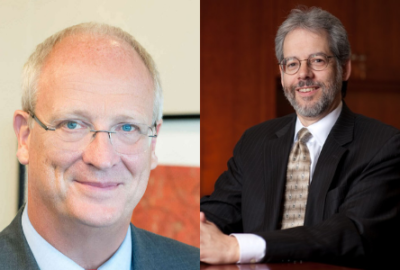

Hubbard Radio Washington DC, LLC. All rights reserved. This website is not intended for users located within the European Economic Area.
The Defense, State, and Energy Departments have launched a consortium. They want to work together to help advance battery technology.
Best listening experience is on Chrome, Firefox or Safari. Subscribe to Federal Drive’s daily audio interviews on Apple Podcasts or PodcastOne.
Every year, it seems, people become more dependent on battery power. Even the Defense Department is looking into electric field vehicles. Now the Defense, State, and Energy Departments have launched a consortium. They want to work together to help advance battery technology. With the details, the acting director of the Energy Efficiency and Renewable Energy office at the Energy Department, Dave Howell joined Federal Drive with Tom Temin.
Interview transcript:
Tom Temin: Mr. Howell, good to have you one.
Dave Howell: Thank you. It’s good to be here.
Tom Temin: First of all, let’s talk about the energy storage Grand Challenge draft roadmap. What is that to kind of set the scene here?
Dave Howell: Sure. So the Energy Storage Grand Challenge is a comprehensive program within the Department of Energy to accelerate the development and commercialization of what we call next generation energy storage technologies with a particular purpose to sustain global leadership in energy storage technology and deployment. It’s a collaboration within the Department of Energy, the Office of Energy Efficiency and Renewable Energy is a big part of it. Office of Electricity, Office of Science, ARPA-E, and many other offices within the Department of Energy have a lot of interest and support for energy storage, technology development and so we all come together. The roadmap will actually develop that comprehensive strategy across all of our offices to help us support the development of an acceleration of technology development. The roadmap will actually cut across lots of different tracks. We call it technology development track, manufacturing and supply chain track. Also, technology transition track how we get these new technologies out into the market. We’re looking at policy and authorities to help enable the establishment of domestic ecosystem for energy storage technologies. And we’ll also have a major pillar on workforce development for the nation.
Tom Temin: It seems like one of the grand challenges is some kind of step function in battery capacity, because only incremental improvements have been made in recent years, and everybody’s waiting for the next big thing in batteries. Is there a next big thing? And is that something you’re hoping to discover?
Dave Howell: Yes, we do have comprehensive programs in the new battery technologies. We’ve made a lot of headway over the past several decades in energy storage capacity, you see that through the lithium ion batteries that are being deployed today, a lot of those technologies that are in those batteries were developed in some of our science and applied research programs. And we do see those being commercialized. And we also see a large opportunity to increase the technology performance of battery storage technologies. Even lithium ion battery still has some headroom for advancement. But other battery technologies, such as lithium metal, a little different than lithium ion, lithium metal can possibly provide two times the energy density of current lithium ion batteries, you hear a lot about solid state chemistry that use in and enabled at the metal technologies also coming into play. And then of course for stationary applications, there’s the batteries like sodium ion, and what we call it masked flow batteries as well.
Tom Temin: And you’re not simply looking at the transportation sector, which is a big one, but also everything down to maybe hearing aids and little tiny batteries.
Dave Howell: Yes, particularly for the Energy Storage Grand Challenge. It has three particular focus areas. One is on the bidirectional storage, which would be what we would typically say is a battery technology. But we are also looking to develop possibly methods to store energy chemically. Also into that storage type medium itself, whether it’s bi-directional electro chemically or chemically, there’s a part of the energy storage grand challenge that’s focused on how to convert that energy to power. So as power conversion equipment is a major component of most energy systems and is included in the Grand Challenge. So the Grand Challenge is focused on many different technologies and many different applications as well.
Tom Temin: Tell us more about the consortium that you have formed with the State Department and Defense Department.
Dave Howell: So it was part of the Energy Storage Grand Challenge. As I mentioned, Energy Storage Grand Challenge has a broad array of technology focus areas really focused more on convening the officers within the Department of Energy to accelerate the development. The Federal Consortium for Advanced Batteries is a little different. It’s more of a subset of what we’re doing in the energy storage grand challenge, but somewhat laser focused on the lithium battery technologies that I mentioned earlier. And it’s actually broader than the Department of Energy. We just signed a charter the Department of Energy with the Department of Commerce, Department of State and the Department of Defense to form what we call the Federal Consortium for Advanced Batteries, primary efforts for the consortium or to coordinate the federal interests that are associated with advanced batteries, and then develop an integrated federal strategy to accelerate the development of a robust secure domestic industrial base for advanced lithium ion batteries. So it’s coordination across the US government agencies, all of our advanced battery efforts to ensure continued alignment with the development and implementation of an integrated domestic battery strategy. This included will identify opportunities for tech transfer across agencies, with particularly focus on the lithium battery technologies sharing information regarding battery advancements, sharing ongoing and planned efforts. Also, we want to collaboratively assess the current domestic and international competitive landscape, engage with key industry stakeholders in the supply chain, and then of course, support any key US government policy initiatives to protect and enhance and gross domestic battery technologies.
Tom Temin: I mean, a big issue is the fact that so much of the raw materials for the advanced batteries comes from China and other places that we’d rather have domestic supplies for, and that would help return manufacturing of these high tech batteries back to the United States. Is that part of the thinking?
Dave Howell: Yes, it is. And as I mentioned, the Federal Consortium is really focused on the battery supply chain all the way starting with raw material supply, and not only raw material supply, but how do you actually refine those materials to be battery grade materials, and then develop those battery grade materials into things like advanced cathode, advanced anodes, and electrolytes all the way through battery cell production, and pack production, even into the end of life of battery spent batteries. How do you recycle them and recover the critical elements in those batteries? You mentioned, critical materials are a big issue in many of the important products in the American economy. You hear about rare earth elements, for example. And those are essential to the manufacture of high strength magnets that are used for electric vehicle motors, and even offshore wind turbines. And lithium ion batteries do not have rare earth elements in them, although they do have critical minerals in them such as cobalt, lithium and nickel. And often those sources of those minerals are from potentially unreliable foreign sources. So the Federal Consortium for Advanced Batteries, our consortium will investigate ways in order to enable the US industrial base to develop and supply those types of materials, whether they’re from domestically sources, or from our allies, as well. So that’s a big part of the Federal Consortium, a reliable robust supply chain of key battery materials in the future.
Tom Temin: So it’s easy to understand how both state and defense would have an interest in this for the long term.
Dave Howell: Yes. And the Department of Commerce, of course.
Tom Temin: And do you think we’ll ever get a double A battery that doesn’t leak when it gets old?
Dave Howell: Well, yes. I’m gonna say yes, because that’s why we’re working on solid state batteries. There’s no liquids in solid state batteries, hence the name. So by definition, there would be a battery that would not leak or liquid there.
Tom Temin: Let’s hope so. Dave Howell is the acting director of the Energy Efficiency and Renewable Energy Office at the Energy Department. Thanks so much for joining me.
Dave Howell: Thank you, Tom. Glad to be here.
Copyright © 2024 Federal News Network. All rights reserved. This website is not intended for users located within the European Economic Area.
Tom Temin is host of the Federal Drive and has been providing insight on federal technology and management issues for more than 30 years.
Follow @tteminWFED


